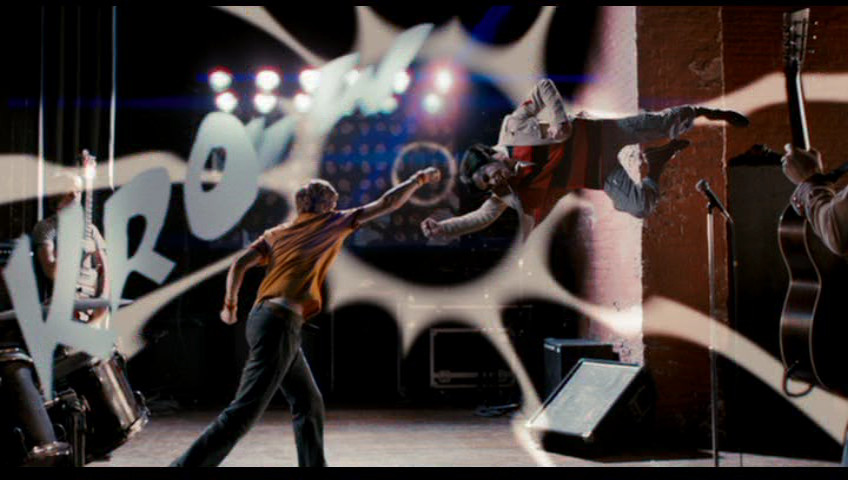Rhetorical Analysis Essay Patricia E. Bauer, My Family, a Word, a Movie
Rhetorical devices (too known equally stylistic devices, persuasive devices, or but rhetoric) are techniques or language used to convey a signal or convince an audience. And they're used by everyone: politicians, businesspeople, even your favorite novelists.
You may already know some of these devices, such every bit similes and metaphors. Others, perhaps not (bdelygmia, we're looking at you). But whether or not yous realized it, you've probably run into all of these devices earlier, and mayhap fifty-fifty used them yourself!
If you oasis't, don't permit their elaborate Greek names fool you — rhetorical devices are really pretty easy to implement. Only before we dive into the dissimilar types of devices and how to use them, let'southward place the four means that rhetorical devices piece of work.
Types of rhetorical devices
Although there exists enough of overlap between rhetorical and literary devices, there's also i significant divergence betwixt the two. While literary devices express ideas artistically, rhetoric appeals to i'southward sensibilities in 4 specific means:
- Logos, an appeal to logic;
- Pathos, an appeal to emotion;
- Ethos, an appeal to ethics; or,
- Kairos, an appeal to time.
These categories haven't inverse since the Ancient Greeks first identified them thousands of years ago. This makes sense, because how we brand decisions haven't changed, either: nosotros however decide with our brain, our centre, our morals, or based on the feeling that we're running out of fourth dimension.
Without farther ado, here is our list of 30 rhetorical devices (plus a few bonus terms) to convince listeners to agree with you — or readers to continue reading your book. Get ready to master the art of rhetoric for yourself!
🖊️
Which contemporary author are you?
Find out which of today'due south greats is your writerly match. Takes one minute!
Listing of rhetorical devices
Accismus
Accismus is the rhetorical refusal of something ane actually wants, to try and convince themselves or others of a different opinion. Similar in one of Aesop's Fables:
Driven past hunger, a fox tried to achieve some grapes hanging high on the vine simply was unable to, although he leaped with all his forcefulness. Equally he went away, the play a trick on remarked 'Oh, yous aren't even ripe notwithstanding! I don't need any sour grapes.' People who speak disparagingly of things that they cannot attain would do well to apply this story to themselves.
Adnomination
A dnomination is the utilise of words with the same root in the same judgement. Like many other rhetorical devices, this is a linguistic play tricks to make statements audio more than persuasive. It's sure to somehow piece of work on someone, somewhere, someday.
Adynaton
Adynata are purposefully hyperbolic metaphors to suggest that something is impossible — like the classic adage, when pigs fly. And hyperbole, of course, is a rhetorical device in and of itself: an excessively exaggerated statement for effect.
Alliteration
Ingemination is the repetition of consonants beyond southwarduccessive, stressed syllables… get it? This near ofttimes means repeating consonants at the beginning of multiple words, as opposed to consonance, which is the repetition of consonants anywhere in consecutive words. (Learn more well-nigh the difference between ingemination and consonance — and other types of repetition — in this guide!)
Edgar Allan Poe's The Raven makes employ of both alliteration and consonance: "And the silken sorry uncertain rustling of each purple pall." "Silken" and "sad" are alliterative, but the consonance continues into "uncertain" and "rustling." And every bit a bonus, it contains assonance — the repetition of vowel sounds — beyond "purple curtain."
Anacoluthon
An anacoluthon is a misdirection that challenges listeners and/or readers to think securely and question their assumptions. For instance, the opening sentence of Kafka's Metamorphosis is a famous anacoluthon because information technology ends somewhere entirely different than where it started:
"When Gregor Samsa woke upward one morning from unsettling dreams, he establish himself inverse in his bed into a monstrous vermin."
Notation that anacoluthons are dissimilar from non-sequiturs, which are unintentional and incoherent — well, merely can anything really be dissimilar from anything else?
Anadiplosis
Anadiplosis is the repetition of the word from the end of one sentence to the first of the next. It has been used past everyone from Shakespeare to Yeats to Yoda:
"Fear leads to anger. Acrimony leads to detest. Detest leads to suffering."

Anaphora
On the other paw, anaphora is the repetition of words or phrases at the beginning of subsequent sentences. Similar in Ginsberg's Howl — no, not that famous opening line, but instead those that follow it:
"Who poverty and tatters and hollow-eyed and loftier sat upwardly smoking in the supernatural darkness of cold-h2o flats floating across the tops of cities contemplating jazz, who bared their brains to Heaven nether the El and saw Mohammedan angels staggering on tenement roofs illuminated, who passed through universities with radiant cool eyes hallucinating Arkansas and Blake-low-cal tragedy amidst the scholars of war…"
Some other, similar rhetorical device is epistrophe: the repetition of words at the end of sentences. And, if you combine the two, you've got a symploce.
Antanagoge
A ntanagoge involves responding to an allegation with a counter-allegation. Antanagoge doesn't necessarily solve the initial problem, simply it does provide an appealing culling. The quintessential example is, "When life gives you lemons, make lemonade." 🍋
Someone might as well use antanagoge to justify something to themselves: "Well, it'due south raining today, but that's fine — I wanted to stay inside anyway."
Anthimeria
Anthimeria is the intentional misuse of one word'southward part of speech, such as using a noun for a verb. It'southward been around for centuries, but is oft used in the modern day, equally "Facebooking" and "adulting" have seamlessly become part of the lexicon.
Antiphrasis
Antiphrasis is a judgement or phrase that means the opposite of what information technology appears to say. Similar how the idiom, "Tell me about information technology" more often than not means, "Don't tell me about it — I already know." Information technology's a subset of a much more than common rhetorical device: irony.
Antonomasia
Antonomasia is, essentially, a rhetorical name. Like "Old Blue Optics," "The Boss," or "The Fab Iv" — appreciating epithets that have the place of proper names like Frank Sinatra, Bruce Springsteen, or the Beatles.
Apophasis
You may have noticed by now that a lot of rhetorical devices stem from irony. Apophasis — as well known as paralipsis, occupatio, praeteritio, preterition, or parasiopesis — is one of these: bringing upward a subject by denying that it should exist brought upward. This is a classic if ofttimes-maligned political tactic, and one oft utilized by the 45th President of the U.s., peculiarly in his colorful tweets. For case:
"Why would Kim Jong-un insult me past calling me 'sometime,' when I would NEVER call him 'curt and fatty?'"
Aporia
Aporia is the rhetorical expression of dubiousness — almost always insincerely. This is a common tool that businesses employ to connect with a consumer base, typically in ads or presentations. For instance, have Steve Jobs' introduction of touchscreen technology:
"Now, how are we gonna communicate this? We don't wanna carry around a mouse, right? What are we gonna do?"
Aposiopesis
Aposiopesis is essentially the rhetorical version of trailing off at the end of your sentence, leaving your listener (or reader) hanging. Like the ending of Mercutio's famous "Queen Mab" voice communication in Romeo & Juliet:
"This is the hag, when maids prevarication on their backs,
That presses them and learns them beginning to conduct,
Making them women of skillful carriage:
This is she... "
Asterismos
Asterismos is simply a phrase beginning with an exclamation. Like every other judgement in Moby-Dick: "Volume! You lie in that location; the fact is, you lot books must know your places." But if no sentence follows, it'southward exclamatio: an emphatic expression like "My give-and-take!" that warrants no follow-up.
Asyndeton
Asyndetonis the removal of conjunctions like "or," "and," or "but" from your writing because the sentence flows better, or more than poetically, without them. This is a favorite technique of Cormac McCarthy, as seen in this passage from Outer Night: "A parson was laboring over the crest of the colina and coming toward them with ane paw raised in blessing, greeting, fending flies."
And like most of the enigmatic author's preferred rhetoric, this asyndeton is almost intentionally confusing; whether the parson is approval or greeting or swatting flies is never clarified. At other times, McCarthy uses polysyndeton, which is essentially asyndeton'due south opposite — the add-on of extra conjunctions ("and then we walked and so nosotros stopped and then we sabbatum on the ground").
Bdelygmia
Befitting its ugly spelling, bdelygmia (or abominatio) is a rhetorical insult — the uglier and more than elaborate, the ameliorate. Like most rhetorical devices, Shakespeare was a big fan. Then was Dr. Seuss:
"You're a foul one, Mr. Grinch, Yous're a nasty wasty skunk, Your centre is full of unwashed socks, your soul is full of gunk, Mr. Grinch. The three words that all-time describe y'all are equally follows, and I quote, 'Stink, stank, stunk!'"

Cacophony
Cacophony is simply the use of words that sound bad together. That may sound pretty random, until you remember that Lewis Carroll invented words for his poem "Jabberwocky" only to make it sound harsh and unmelodious:
"'Twas brillig, and the slithy toves
Did curlicue and gimble in the wabe:
All mimsy were the borogoves,
And the mome raths outgrabe."
And information technology goes hand in hand with euphony — the apply of words that sound practiced together, similar this passage from an Emily Dickinson poem:
"Oars divide the Ocean, / Too silvery for a seam."
Chiasmus
"Despised, if ugly; if she's fair, betrayed." This excerpt from Mary Leapor'south Essay on Woman is not bad example of chiasmus: the repetition and/or reversal of words or grammatical construction across two phrases. More specific isantimetabole: the switching of words or phrases in order to advise truth. (Ask not what rhetorical devices tin do for y'all. Enquire what you lot can do for rhetorical devices.)
Climax
Narrative arcs aren't only for novels. Sentences can have a climax, too — the initial words and clauses build to a meridian, saving the most of import point for terminal. Nosotros've been using climaxes rhetorically since at least Corinthians: "In that location are three things that will endure: religion, hope, and love. Only the greatest of these is dear."
Dysphemism
Dysphemism is a description that is explicitly offensive to its discipline and/or its audience. It stands in contrast to a euphemism, which strives to avoid outright offense, just still has unfortunate connotations. Almost racial epithets started as the latter, but are recognized today every bit the former.
Meiosis
If you lot've ever understated something earlier, that'south meiosis — similar the assertion that United kingdom of great britain and northern ireland is simply "across the pond" from the Americas. The reverse — rhetorical exaggeration — is called auxesis.
Onomatopoeia
Wham! Pow! Crunch! These are all examples of onomatopoeia, a word for a sound that phonetically resembles the sound itself. Which ways the finale of the 1966 Batman is the most onomatopoeic motion-picture show scene of all fourth dimension.

Personification
Personification describes things and concepts using human being characteristics. It'due south easier for humans to understand a concept when it's straight related to them, which is why this is such an constructive rhetorical device!
Personification appears in most all forms of literature — fifty-fifty unproblematic sentences like "the warning screamed" or "the wind howled" would authorize as personification. Anthropomorphism, which actuallyturnsnon-humans into human-like forms, is less mutual, only often seen in children's stories and cartoons similarPeter Rabbit and Winnie-the-Pooh.
Pleonasm
Pleonasms are redundant phrases that emphasize the nature of the subject. Certain words are so overused that they've lost significant — darkness, nice, etc. Even so, "black darkness" or "pleasantly nice" reinvigorate that meaning, fifty-fifty if the phrases are technically redundant.
🖋️
Which writing app is correct for you?
Observe out here! Takes 30 seconds
Rhetorical comparisons
Some of the near prevalent rhetorical devices are figures of voice communication that compare one thing to another. Two of these, yous surely know: the simile and the metaphor.But there is a third, hypocatastasis, that is just every bit common… and useful.
The distinctions between the three are pretty simple. A simile compares two things using like or as: "You are like a monster." A metaphor compares them by asserting that they're the same: "You're a monster." And with hypocatastasis, the comparison itself is implied: "Monster!"
If you tin't go enough rhetorical comparisons, cheque out these 90+ examples of metaphors in literature and popular culture!
Rhetorical question
You've probably heard of a rhetorical question, too: a question asked to make a point rather than to be answered. Technically, this figure of speech is chosen interrogatio, merely plenty of other rhetorical devices take the form of questions.
If you lot pose a rhetorical question simply to answer information technology yourself, that'southward hypophora ("Am I hungry? Yep, I think I am"). And if your rhetorical question infers or asks for a large audience'due south opinion ("Friends, Romans, countrymen [...] Did this in Caesar seem ambitious?") that's anacoenosis — though it more often than not doesn't warrant an respond, either.
Synecdoche
Synecdoche is a rhetorical device wherein a function of ane affair represents its whole. This differs slightly from metonymy, in which a unmarried affair represents a larger institution. And so if you referred to an old king as "greybeard," that would be synecdoche. If you referred to him as "the crown," it would be metonymy.
Tmesis
Have you e'er, in a fit of outrage, referred to something un-effing-believable? If you have, congratulations on discovering tmesis: the separation of 1 word into two parts, with a third word placed in between for emphasis.

Zeugma
Zeugma, also called syllepsis, places two nouns with different meanings in a like position in a sentence. This is a grammatical trick that can be used rhetorically as well. Marking Twain was a master at this: "They covered themselves with dust and glory."
Some other example might be: "He caught the train and a bad cold." Though you'd "catch" these things in very different means, the phrase still works because the same verb applies to both. Authors often use zeugma in clever wordplay, and sometimes it fifty-fifty enters everyday conversation. (My grandmother, for example, uses zeugma to describe staticky habiliment: "This shirt attracts everything but a man.")
Congrats on getting to the end of our rhetorical devices listing! Of grade, this might feel a bit like a list of fancy names for things you already do. If so, that's great — yous're already well on your manner to mastering the fine art of rhetoric. And now that you know the specifics, you can take the next pace: implementing these techniques in your writing and swaying readers onto your side.
Leave whatsoever thoughts or questions about rhetorical devices in the comments beneath!
scarbroughupout1948.blogspot.com
Source: https://blog.reedsy.com/rhetorical-devices/

0 Response to "Rhetorical Analysis Essay Patricia E. Bauer, My Family, a Word, a Movie"
Post a Comment